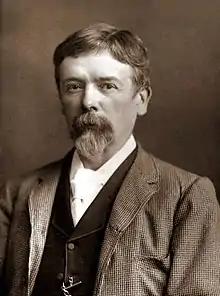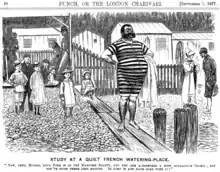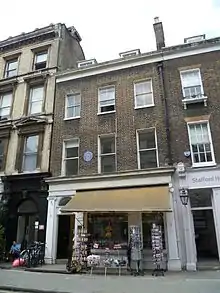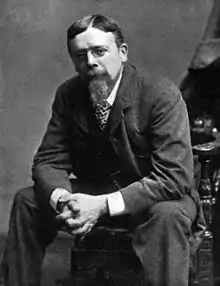George du Maurier | |
|---|---|
 | |
| Born | George Louis Palmella Busson du Maurier 6 March 1834 Paris, France |
| Died | 8 October 1896 (aged 62) Hampstead, England |
| Occupation | Cartoonist, illustrator, novelist |
| Spouse |
Emma Wightwick (m. 1863) |
| Children | 5, including Guy, Sylvia, and Gerald |

Cartoon by du Maurier from Punch
George Louis Palmella Busson du Maurier (6 March 1834 – 8 October 1896) was a Franco-British cartoonist and writer known for work in Punch and a Gothic novel Trilby, featuring the character Svengali. His son was the actor Sir Gerald du Maurier. The writers Angela du Maurier and Dame Daphne du Maurier and the artist Jeanne du Maurier were all granddaughters of George. He was also father of Sylvia Llewelyn Davies and grandfather of the five boys who inspired J. M. Barrie's Peter Pan.
Early life
George du Maurier was born in Paris, France, son of Louis-Mathurin Busson du Maurier and wife Ellen Clarke, daughter of the Regency courtesan Mary Anne Clarke. He was brought up to believe his aristocratic grandparents had fled from France during the Revolution, leaving vast estates behind, to live in England as émigrés. In fact, du Maurier's grandfather, Robert-Mathurin Busson, was a tradesman who left Paris, France, in 1789 to avoid charges of fraud and later changed the family name to the grander-sounding du Maurier.[1]
Du Maurier studied art in Paris, France, in the studio of Charles Gleyre,[2] and moved to Antwerp, Belgium, where he lost the vision in his left eye. He consulted an oculist in Düsseldorf, Rhineland, Prussia, German Confederation. He was reportedly studying chemistry at University College, London, in 1851.[3] He is recorded in the 1861 England Census as a lodger at 85 Newman St in Marylebone.[4]
He met Emma Wightwick in 1853 and married her a decade later, on 3 January 1863, at St Marylebone, Westminster.[5][6] Moving frequently over the course of their marriage, the couple first settled in Hampstead in 1869, initially at Gang Moor near the Whitestone Pond for three years, before moving to 27 Church Row and later at New Grove House in 1881.[7][8][9] In 1891, the family is recorded as residing at 2 Porchester Rd in Paddington.[10] They had five children: Beatrix (known as Trixy), Guy, Sylvia, Marie Louise (known as May) and Gerald.[11]
Career

Cartoonist
Du Maurier became a member of staff at the British satirical magazine Punch in 1865, drawing two cartoons a week. His commonest targets were the affected manners of Victorian society, the bourgeoisie and members of Britain's growing middle class in particular. His most enduring cartoon, True Humility (1895), popularised the expressions "good in parts" and "a curate's egg". In it, a bishop addresses a humble curate, whom he has invited to breakfast: "I'm afraid you've got a bad egg, Mr. Jones." The curate replies, "Oh no, my Lord, I assure you – parts of it are excellent!"[12] The gag was not original to du Maurier, however, as it had appeared in a similar cartoon a few months earlier in Judy, a less widely read competitor to Punch.[13] In an earlier (1884) cartoon, du Maurier coined the expression "bedside manner", with which he satirised medical care.[14] Another of his notable cartoons depicted a fanciful videophone conversation in 1879, using a device he called "Edison's telephonoscope".[15]
While producing black-and-white drawings for Punch, du Maurier created illustrations for several other popular periodicals: Harper's, The Graphic, The Illustrated Times, The Cornhill Magazine, and the religious periodical Good Words.[16] Furthermore, he did illustrations for the serialisation of Charles Warren Adams's The Notting Hill Mystery, which is often seen as the first detective story of novel length to have appeared in English.[17] Among several other novels he illustrated was Misunderstood by Florence Montgomery in 1873.[18]
Writer

His deteriorating eyesight caused du Maurier to reduce his involvement with Punch in 1891 and settle in Hampstead, where he wrote three novels. His first, Peter Ibbetson (1891), was a modest success at the time and later adapted for stage and screen, most notably in a 1935 film, and as an opera.[19]
His second novel, Trilby, published in 1894, fitted into the gothic horror genre that was undergoing a revival. Hugely popular, it tells of a poor artist's model, Trilby O'Ferrall, transformed into a diva under the spell of an evil musical genius, Svengali. Soap, songs, dances, toothpaste, and even the city of Trilby, Florida, were named after her, as was the variety of soft felt hat with an indented crown worn in the London stage dramatisation of the novel. The plot inspired Gaston Leroux's 1910 novel Phantom of the Opera and innumerable works derived from it.[20] Du Maurier eventually came to dislike the persistent attention the novel was given.
The third novel was a long, largely autobiographical work entitled The Martian, published posthumously in 1898.
Death and legacy

Du Maurier died on 8 October 1896 and was buried in St John-at-Hampstead churchyard in Hampstead. The success of his writings and illustrations allowed du Maurier to leave a then staggering amount of £47,555 in his will.[21]
Du Maurier was a close friend of Henry James, the novelist; their relationship was fictionalised in David Lodge's Author, Author (2004).[22]

Illustration by du Maurier for Punch, 17 March 1866, parodying Pre-Raphaelitism
Bibliography
- Peter Ibbetson (1891), also 1917 play; adapted in 1935 by Henry Hathaway into a film starring Gary Cooper; also adapted as an opera by Deems Taylor in 1931; and in 1988 dramatised as a radio play for BBC Radio 4 Saturday-Night Theatre by David Buck.[23]
- Trilby (1894) published first as a magazine serial in 8 parts
- The Martian (1898)
- Social Pictorial Satire (1898) (Harper's New Monthly Magazine)
Film adaptations
- Trilby (1914), starring Herbert Beerbohm Tree and Viva Birkett
- Trilby (1915), starring Wilton Lackaye and Clara Kimball Young
- Forever (1921), starring Wallace Reid and Elsie Ferguson
- Trilby (1923), starring Arthur Edmund Carewe and Andrée Lafayette
- Svengali (1927), starring Paul Wegener and Anita Dorris
- Svengali (1931), starring John Barrymore and Marian Marsh
- Peter Ibbetson (1935), starring Gary Cooper and Ann Harding
- The Guilt of Janet Ames (1947), starring Melvyn Douglas and Rosalind Russell
- Svengali (1954), starring Donald Wolfit and Hildegard Knef
- Svengali (1983), starring Peter O'Toole and Jodie Foster
See also
References
- ↑ "George Du Maurier, Illustrator and Novelist". www.victorianweb.org.
- ↑ Ainger, Alfred (1901). . Dictionary of National Biography (1st supplement). Vol. 2. pp. 161–166.
- ↑ London, England: Oxford University Press; Volume: Vol 22; Page: 370. Ancestry.com. Dictionary of National Biography, Volumes 1–22 [database on-line]. Provo, UT, USA: Ancestry.com Operations, Inc., 2010. This collection was indexed by Ancestry World Archives Project contributors. Stephen, Sir Leslie, ed. Dictionary of National Biography, 1921–1922. Volumes 1–22. London, England: Oxford University Press, 1921–1922. Dictionary of National Biography, 1921–1922, Oxford University Press, London, England.
- ↑ Class: RG 9; Piece: 66; Folio: 57; Page: 37; GSU roll: 542567. Ancestry.com. 1861 England Census [database on-line]. Provo, UT, USA: Ancestry.com Operations Inc, 2005. Census Returns of England and Wales, 1861. Kew, Surrey, England: The National Archives of the UK (TNA): Public Record Office (PRO), 1861. Data imaged from The National Archives, London, England.
- ↑ "George du Maurier, Illustrator and Novelist".
- ↑ London Metropolitan Archives; London, England; Reference Number: P89/mry1/235. Ancestry.com. London, England, Church of England Marriages and Banns, 1754-1932 [database on-line]. Provo, UT, USA: Ancestry.com Operations, Inc., 2010. Church of England Parish Registers. London Metropolitan Archives, London.
- ↑ "A History of the County of Middlesex: Volume 9, Hampstead, Paddington. British History Online". Victoria County History. 1989. Retrieved 26 June 2020.
- ↑ Class: RG10; Piece: 192; Folio: 4; Page: 2; GSU roll: 823312. Ancestry.com. 1871 England Census [database on-line]. Provo, UT, USA: Ancestry.com Operations Inc, 2004. Census Returns of England and Wales, 1871. Kew, Surrey, England: The National Archives of the UK (TNA): Public Record Office (PRO), 1871. Data imaged from the National Archives, London, England.
- ↑ Mary Cathcart Borer (1976), Hampstead and Highgate: The story of two hilltop villages. London: W. H. Allen & Co., p. 169. ISBN 0491018274
- ↑ The National Archives of the UK (TNA); Kew, Surrey, England; Class: RG12; Piece: 15; Folio: 174; Page: 3. Ancestry.com. 1891 England Census [database on-line]. Provo, UT, USA: Ancestry.com Operations Inc, 2005. Census Returns of England and Wales, 1891. Kew, Surrey, England: The National Archives of the UK (TNA): Public Record Office (PRO), 1891.
- ↑ Class: RG11; Piece: 166; Folio: 99; Page: 19; GSU roll: 1341036. Ancestry.com and The Church of Jesus Christ of Latter-day Saints. 1881 England Census [database on-line]. Provo, UT, USA: Ancestry.com Operations Inc, 2004. Census Returns of England and Wales, 1881. Kew, Surrey, England: The National Archives of the UK (TNA): Public Record Office (PRO), 1881.
- ↑ Egan, Kieran (2004). Getting It Wrong from the Beginning: Our Progressivist Inheritance from Herbert Spencer, John Dewey, and Jean Piaget. Yale University Press. pp. 22–23. ISBN 9780300105100.
- ↑ "The Curate's Egg: Parts of It Are Excellent". Quote Investigator. Retrieved 5 March 2019.
- ↑ Benham, W. Gurney. A Book of Quotations, Proverbs and Household Words: A Collection of Quotations from British and American Authors, Ancient and Modern. J. B. Lippincott, 1907, p. 458.
- ↑ Roberts, Ivy (2017). "'Edison's Telephonoscope': the visual telephone and the satire of electric light mania". Early Popular Visual Culture. 15 (1): 1–25. doi:10.1080/17460654.2016.1232656. ISSN 1746-0654. S2CID 191910615.
- ↑ Souter, Nick and Tessa (2012). The Illustration Handbook: A guide to the world's greatest illustrators. Oceana. p. 32. ISBN 9781845734732.
- ↑ The original edition illustrated is available at the Internet Archive: Section 1 Retrieved 1 February 2013. Once a Week, Vol. 7, p. 617, 29 November 1862 and at weekly intervals.
- ↑ The Feminist Companion to Literature in English, eds. Virginia Blain, Patricia Clements and Isobel Grundy (London: Batsford, 1990), p. 752.
- ↑ Flieger, Verlyn (2001). A Question of Time: J. R. R. Tolkien's Road to Faërie. Kent: Kent State University Press. pp. 30–35. ISBN 9780873386999.
- ↑ Nancy, Glazener (24 March 2011). "The novel in postbellum print culture". The Cambridge History of the American Novel. Edited by Leonard Cassuto. Cambridge University Press. p. 337. ISBN 9781316184431.
- ↑ Ancestry.com. England & Wales, National Probate Calendar (Index of Wills and Administrations), 1858-1995[database on-line]. Provo, UT, USA: Ancestry.com Operations, Inc., 2010. Principal Probate Registry. Calendar of the Grants of Probate and Letters of Administration made in the Probate Registries of the High Court of Justice in England. London, England.
- ↑ Harrison, Sophie, "'Author, Author': The Portrait of a Layabout" The New York Times, October 10, 2004.
- ↑ Saturday-Night Theatre: Peter Ibbetson – BBC – Radio Times
Further reading
- Simon Cooke and Paul Goldman. George Du Maurier: Illustrator, Author, Critic. Beyond Svengali. Routledge, 2016
- Richard Kelly. George du Maurier. Twayne, 1983
- Richard Kelly. The Art of George du Maurier. Scolar Press, 1996
- Leonée Ormond. George du Maurier. Routledge & Kegan Paul, London, 1969
- "Du Maurier", a poem by Florence Earle Coates first published in 1898
External links
- Ainger, Alfred (1901). . Dictionary of National Biography (1st supplement). Vol. 2. pp. 161–166.
- Works by George du Maurier at Project Gutenberg
- Works by or about George du Maurier at Internet Archive
- Works by or about George du Maurier at HathiTrust
- Works by or about George du Maurier at GoogleBooks
- Works by George du Maurier at LibriVox (public domain audiobooks)

- A gallery of George du Maurier works for Punch magazine
- George du Maurier at The Victorian Web
- George du Maurier at Lambiek.net
- Works by George Du Maurier (illustrator) at Faded Page (Canada)
- George du Maurier's cartoon Love-Agony satirizing the Aesthetic Movement and Oscar Wilde.
- George du Maurier cartoons at CartoonStock (Commercial site)
- Telephonoscope, a cartoon of a television/videophone in 1879
- "Archival material relating to George du Maurier". UK National Archives.
- Portraits of George Louis Palmella Busson Du Maurier at the National Portrait Gallery, London
- Blue Plaque at 91, Great Russell Street, Bloomsbury, London
- George du Maurier at University of Exeter Special Collections
- George du Maurier at Library of Congress, with 77 library catalogue records